Agent Under Fire Q&A
We talk to the producers of EA's upcoming PS2 Bond game.
The game now known as Agent Under Fire has been in development, in some respect, for a long time now. Originally the PS2 version of The World Is Not Enough, the game was, at one point, among the most anticipated titles in development for that platform. However, at some point in its developmental life, certain decisions were made that would wholly alter what the game will ultimately end up as--and that would change its title to boot.
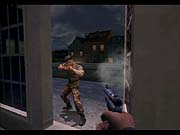
Agent Under Fire ended up being something quite unlike any recent Bond game. First off, it's not based on any established Bond narrative. Rather, the developers were given free reign to conceive their own story and build a game around it. And so they've done. Drawing heavily from the rich mythos and extrapolating on it for the purpose of creating a compelling action game, the EA team behind Agent Under Fire has created a multifaceted game. Though it's a first-person shooter at its core (albeit one skewed toward spy action), Agent Under Fire will feature a healthy dose of driving missions powered by a genuine driving engine and developed by the Need for Speed team.
Quite interested in seeing how this all panned out, we talked to EA's Jon Horsley, Scott Blackwood, and Brad Gour at length about the game. Read on to hear about the game in their own words.
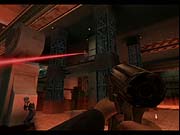
GameSpot: How has the body of James Bond games affected or otherwise influenced the development of Agent Under Fire?
Jon Horsley: We played them all, of course, and tried to understand from each what elements worked well and which could be improved. Our goal was to bring the complete Bond experience to life. The first step was to craft a compelling, original storyline that players and Bond fans would embrace. On top of that, we would deliver all the exotic locations, sexy women, dangerous weapons, spy gadgets, and fast cars that Bond fans expect. And a wicked multiplayer mode, too. Each former Bond game provided valuable lessons.
GS: How do you feel it stacks up against previous Bond games?
JH: We think Agent Under Fire provides the most complete and authentic Bond experience ever offered. It has an original storyline, which allows us to create and maintain dramatic suspense, for instance. We provide a collection of cool spy gadgets and powerful weaponry. It is by far the most sexy and rich Bond experience ever offered to the player. Coupled with racing, multiplayer, and our next-generation graphics, I think we've succeeded.
GS: Has the fact that its story is self-contained liberated the team at all, or would you have rather worked within an established story?
JH: MGM and Danjaq create absolutely superb films, but their locations and plots don't always lend themselves well to interactive gameplay. They understand that and have been very supportive of our original storyline. Not to mention that an original Bond storyline allows us to offer numerous elements of surprise and unpredictable situations to further heighten the player's experience. Also, an original game story guarantees that our technology, art, and gameplay all complement the plot. That said, our strong preference is an original game story.
GS: What key players in the Bond mythology will make appearances? Any famous allies or villains?
JH: Characters like M and R appear in the game, of course, but it is a completely original storyline. These characters' likenesses are not based on any of the actors who have appeared in past Bond films as well. We collaborated with MGM and Danjaq, along with professional screenwriters, to craft the story. We have all-new allies and villains. The player teams up with a sexy CIA operative named Zoe Nightshade, for instance, which is new.
GS: Has the lack of an established Bond narrative affected the game's production in any way? That is, voice actors, narrative setting, and the like?
JH: After collaborating with the best storytellers in the world, we partnered with the best CGI houses in the world to bring the game to life. Industrial Light & Magic, Pacific Data Images, and others worked on the cinematics and animations that the player will experience in the game. It turned out stunningly.
GS: What will the game's FPS levels be like? On what sorts of gameplay will they focus?
JH: In Agent Under Fire, we put the player in the position to be Bond, with all the implications. He is not allowed to harm innocents and he is encouraged to use his wits to overcome his enemies. To that end, he has a number of gadgets and ways to use them to maneuver and outsmart [those enemies.] We certainly have lots of action, and the player does use weaponry, but he or she has to do so with intelligence and care. In addition, most of our missions have "stealth routes" that allow the player to avoid mass combat and fight with precision, if he or she chooses.
GS: To talk numbers, how many missions will there be? What about weapons?
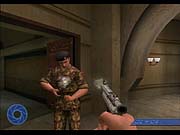
JH: There will be more than 10 separate missions in Agent Under Fire, including driving, with a variety of weapons and gadgets. We wanted to offer the player substantial depth and variety--we offer weapons with scopes, alternative fire modes, silencers, and different types of ammunition. The range in the first-person levels includes sniper rifles, grenade launchers, submachine guns, powerful handguns, and shotguns. The players acquire their weaponry within the mission from their enemies, so occasionally they are also using a rocket launcher and manning .50 caliber machine guns to combat helicopters or other large craft. Same with gadgets--we have Q-lasers that will burn locks, a Q-claw that will allow the player to grapple on certain surfaces, as well as other gadgets like Q-glasses that have X-ray vision. Lots of different spy gadgets complete the Bond experience.
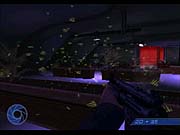
GS: Will the game change significantly if it's played through in different difficulty settings?
JH: The difficulty settings in Agent Under Fire allow the player to be comfortable at different levels of skill. However, the only way to get a great score, find Easter eggs, and earn Bond rewards is to play well in the higher difficulty settings, particularly in the later missions. High scores provide the player with cool multiplayer features and single-player rewards, like a golden gun.
GS: Solid multiplayer modes have become a staple in Bond games. What will your game's multiplayer mode be like?
JH: We support up to four players in split multiplayer mode with many maps and different options. We wanted to provide a fun experience for the players that felt like Bond. We have four different multiplayer game modes that range from 00 Agent combat training to acting as a guardian for a visiting diplomat. Team play and solo mode is supported. Multiplayer features very rich graphics and fast action.
GS: Has it been difficult to work with the PS2? What interesting features has it allowed the team to implement?
JH: The PS2 is a powerful platform, and I think we have taken advantage of that power by delivering a fantastic looking game with a high frame rate. For Agent Under Fire, we wrote a custom renderer and lighting package, plus a visual effects package that really lets the box sing. Our engineers and artists did a wonderful job. The game is huge and it would only fit on a DVD, so I am grateful to Sony for providing that option.
GS: Care to talk about the game's delay and title change? What happened in the transition from TWINE to Agent Under Fire? What caused it?
JH: We thought we could deliver a good TWINE game for the PS2--but we also thought we could combine forces with some of our other studios and deliver a great original Bond experience with Agent Under Fire. The extra time has provided us the opportunity to create an entirely new game, not tied to a specific movie, and address some points that we knew we couldn't get into TWINE under that timeline. And we cherish and respect our players too much to pass up the opportunity. MGM and Danjaq were gracious and provided great partnership, so we just went for it! The results speak for themselves, I think.
Cars
GS: What role do the driving elements play in the overall game? How large of a role will they play?
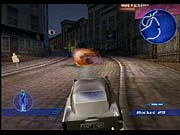
Scott Blackwood: The goal of Agent Under Fire is to provide a complete Bond experience including guns, gadgets, exotic locations, seductive women, and exotic vehicles. Adding the driving not only fills out this mix, but it also adds continuity to the original storyline. In one mission, you're on foot infiltrating a facility in Hong Kong--next, you're escaping in a BMW 750iL, holding your attackers at bay as you race through the streets of Hong Kong. Placing these missions back-to-back adds gameplay diversity and helps tie all the levels together to create a better flow. The player can experience all facets of being James Bond, just as he is in the movies.
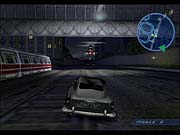
GS: How many driving missions will there be? What will they play like?
SB: Four of the missions in Agent Under Fire will be vehicle-based. I use the term "vehicle-based" because there are two different game mechanics used in the driving levels. One is third-person driving, similar to a Need for Speed racing title, only now your vehicles are armed to the teeth with Q Branch weaponry. You navigate through large cities, encountering enemies in other vehicles while achieving your objectives.
The second style of gameplay is what we refer to as rail-shooter missions. Here the player is in first-person view, but in a vehicle that is being controlled by someone or something else. An example of this is racing through the streets of Hong Kong in the BMW 750iL. CIA agent Zoe Nightshade is driving, and as Bond, the player is standing out of the sunroof fending off wave after wave of attackers with a variety of weapons.
GS: From a technical standpoint, how do the driving missions stack up against those found in pure mission-based driving games?
SB: From a feature standpoint, they are similar, with large open worlds, stunning environments, traffic, pedestrians, objects to smash through, shortcuts, and so on. But in Agent Under Fire, you have exotic cars equipped with an arsenal of cool Q Branch gadgets and powerful weapons to help deal with a variety of intelligent enemies. And you are James Bond! From a technical standpoint, you're getting driving excitement and levels from the team that has been developing the Need for Speed series since the days of 3DO. These four levels and all the art and technology behind them have been in the making for well over a year now.
GS: How many vehicles will players have access to?
SB: In the third-person driving missions in Agent Under Fire, the player will have access to classic Bond cars such as the BMW Z8 and Aston Martin DB5, both suitably equipped with armor and weaponry (of course). There is also a bonus car that I think will be quite familiar to Bond fans, but I'll leave it to the players to find out which one. In the rail-shooter missions, Bond is along for the ride in a BMW 750iL, a tram through an underwater transport system, and best of all...well, again, I don't want to give that away!
GS: Can you elaborate on the weapons?
SB: As I mentioned before, each of the cars will be decked out with state-of-the-art Q Branch weaponry. These will include forward-mounted rockets, homing missiles, machine guns, oil slicks, smoke screens, and more.
GS: What types of opposition can players expect to confront?
SB: In Agent Under Fire, the player will be confronted with a variety of threats in the driving levels, including well-armed foot soldiers; sedans and limos with sunroof and side-window gunners; armored vans with rocket-wielding bad guys in the back; helicopters equipped with rockets, machine guns, and side-door gunners; and a few tanks thrown in for good measure.
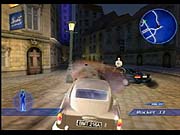
GS: Can you talk about the game's technical aspects? How many polys will the vehicles and environments be composed of?
Brad Gour: Well, I can tell you it's a lot more than in anything we've previously done--more than 3,000 polys for the Bond cars and more than 25,000 for the worlds and effects (onscreen). The cars are particularly detailed, with multiple animating weapon systems adding to the complexity. But with Agent Under Fire, we are trying to push the limits on much more than just the poly count. With this style of game, intense action is critical, so we devised a system in which we could simultaneously support a huge number of interactive elements--traffic, destructible objects, fleeing pedestrians, henchman, rockets, missiles, and bullets--and not lose frame rate. In the end, we came up with a solution that achieves that goal and does so by making excellent use of the PS2's unique assets, namely the vector units. All the hardware is kept busy nearly all the time on the PS2, which is really a challenge.
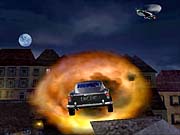
GS: Is the game built around any piece of established technology?
BG: Although the team's roots are in the Need For Speed driving products, we started with a clean slate for Agent Under Fire. Everything, from physics and artificial intelligence to rendering, is new or completely revamped. Some of our process remains similar to our last product, but enhanced to meet the needs of this mission-based game. We do use in-house tools and libraries, most notably EAGL, which is the Electronic Arts Graphics Library. It's been a great benefit to us in many ways. It helped us leverage the unique and powerful hardware of the PS2. We're very happy with the state of the technology.
GS: What was it like working on the game's driving aspect, when the bulk of the team was located remotely?
SB: It has been much less difficult than we originally thought. We've been able to manage separate code bases for the most part, so the technical challenge was mitigated to a fair extent. Maintaining tight lines of communication has been the most critical component in achieving visual and design consistency throughout all the shared parts of Agent Under Fire.
GS: Finally, do you have any words for fans of Bond games?
JH: If you've ever dreamed of being James Bond, look no further. Agent Under Fire is a thrilling game and the Bond experience for 2001.
Got a news tip or want to contact us directly? Email news@gamespot.com
Join the conversation